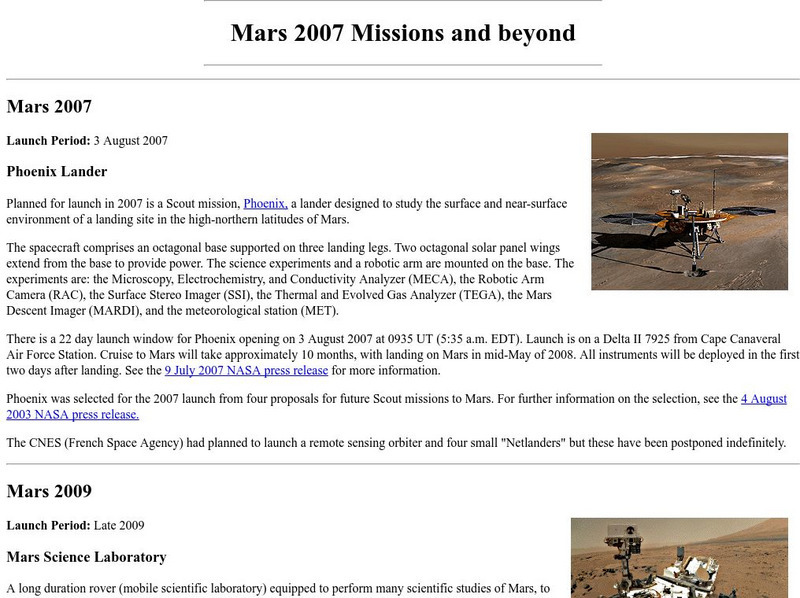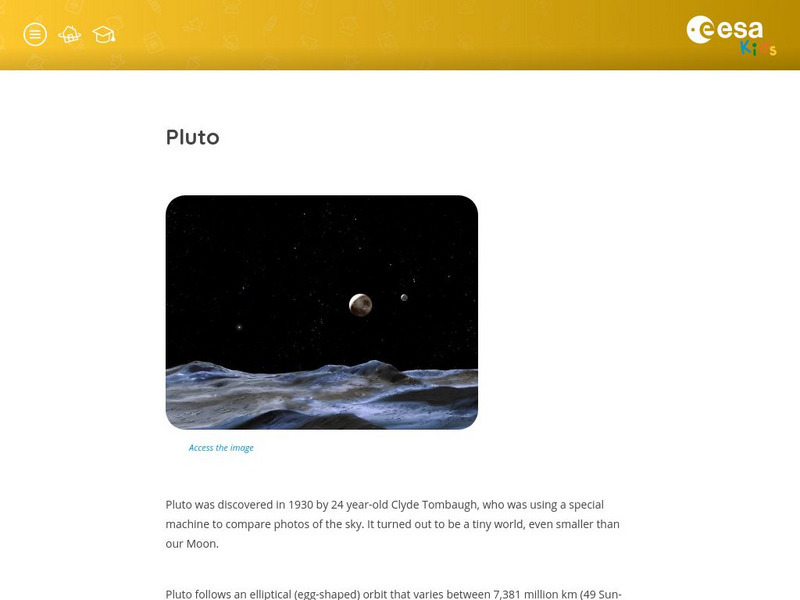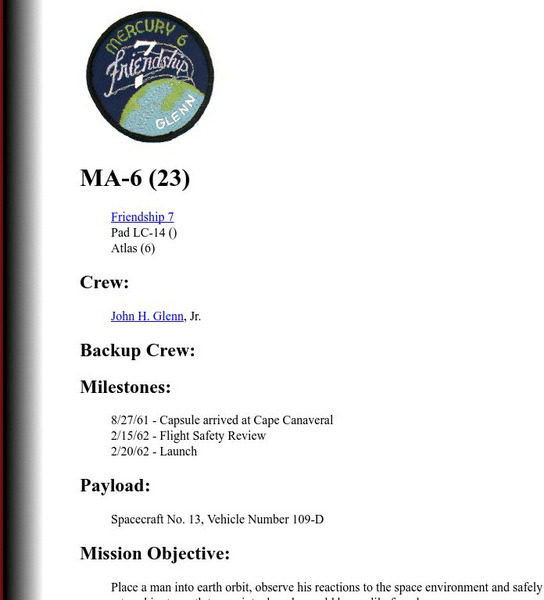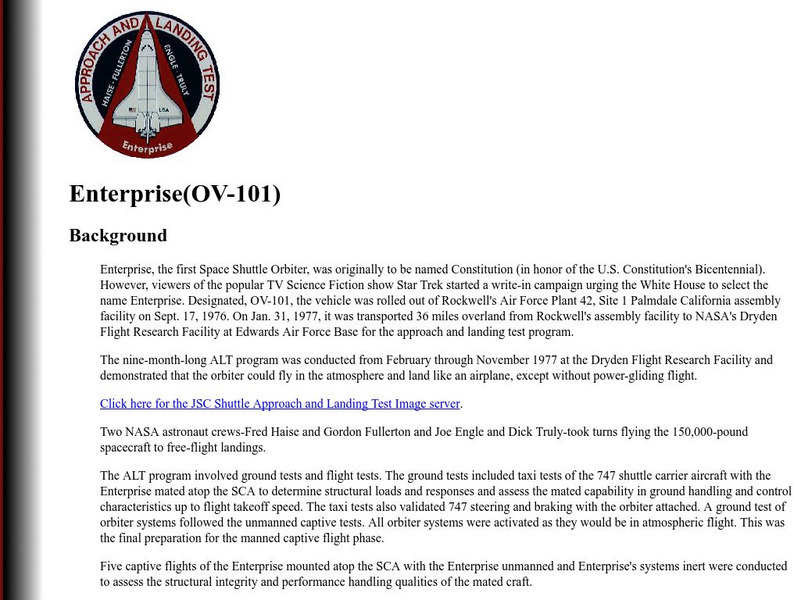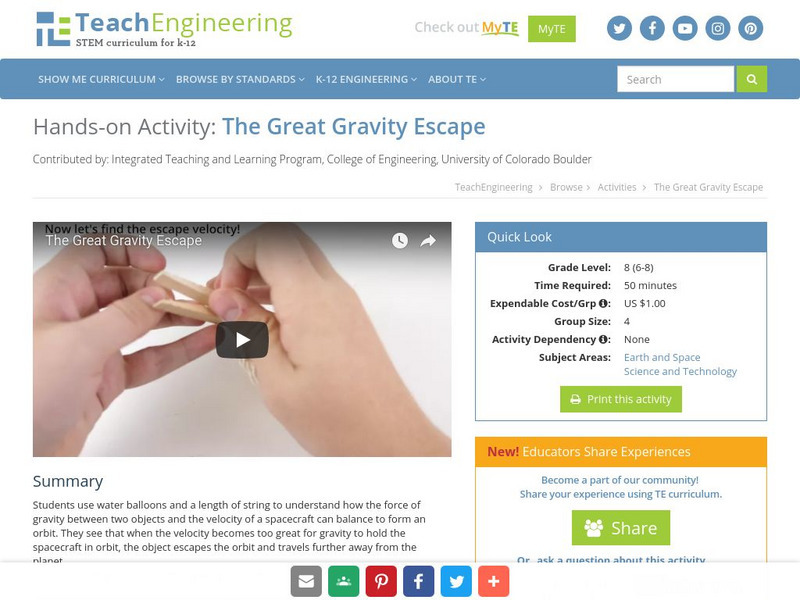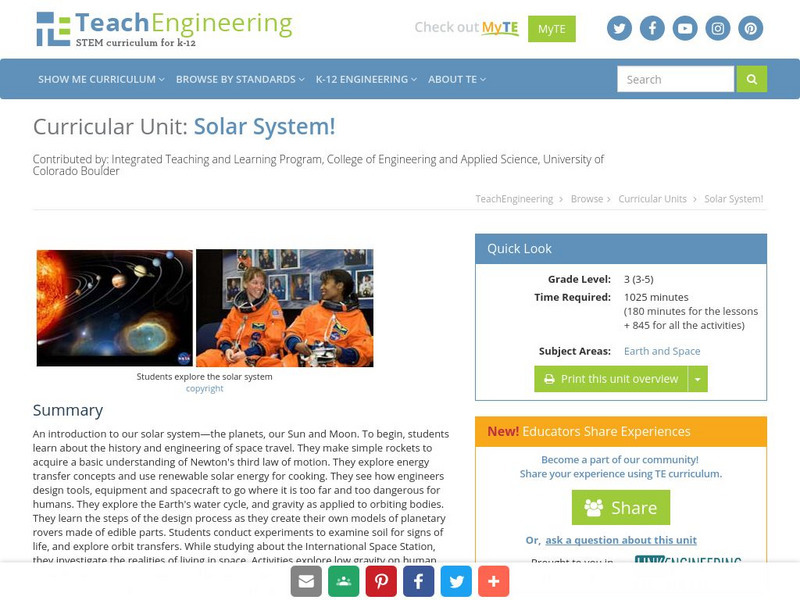Hi, what do you want to do?
NASA
Nasa Space Science Data Archive: Mars 2007 and Beyond
Check this resource for NASA's present, past, and future Mars' missions. Launch periods, descriptions of the mission, and related press releases are provided for each mission.
European Space Agency
European Space Agency: Esa Kids: Our Universe: Pluto
A basic overview of the dwarf planet Pluto. Links to information about the other planets and objects in our solar system are included.
European Space Agency
European Space Agency: Esa Kids: Our Universe: Mars
A basic overview of the planet Mars. Links to information about the other planets and objects in our solar system are included.
NASA
Nasa: Station Location
This site provides real time data on the current orbital location of the International Space Station. Updated once per minute.
Other
Historic Wings: John Glenn Friendship 7
The story of America's first astronaut to orbit the earth during the Mercury Space program. After launching the program click on continue or on the numbers to learn about the story of the Mercury program and the first American to orbit...
Science Museum, London
Making the Modern World: Gravity
The learning module helps students gain a deeper understanding of gravity. Some topics explored are orbits, the mission to the Moon, and the first space walk. Activities and videos are included.
TeachEngineering
Teach Engineering: The Great Gravity Escape
Learners use water balloons and a length of string to understand how gravity and the velocity of a spacecraft balance to form an orbit. They see that when the velocity becomes too great for gravity to hold onto an object, the object...
Digital Public Library of America
Dpla: Race to the Moon
In 1955, the US and the USSR each announced plans to launch a satellite into orbit. Thus began the race to the moon. Throughout the 1960s and 1970s, the American space program and its new classes of astronauts achieved breakthroughs in...
TeachEngineering
Teach Engineering: Plot Your Course Navigation
In this unit, students learn the very basics of navigation, including the different kinds of navigation and their purpose. The concepts of relative and absolute location, latitude, longitude and cardinal directions are discussed, as well...
NASA
Nasa: Radar Images
See amazing radar images of Earth taken from the space shuttle orbiting high above the surface. Categories include archeology, geology, volcanoes, and more! Visit the NASA/JPL Imaging Radar Program link for more images and information.
Ohio State University
Ohio State University: Chronology of John Herschel Glenn
This resource offers a chronology of John Glenn from his birth in 1921 to the present, including important events from his early spaceflights, his political career, and his return to space on board the Space Shuttle Discovery in 1998.
Space Telescope Science Institute
Hubble Site: Hand Held Hubble
This site has an activity to make a hand-held telescope. "The Hubble Space Telescope that's orbiting Earth right now is the size of a school bus, but you can make a model of it that you can hold in your hands!"
Massachusetts Institute of Technology
Mit: Open Course Ware: Earth, Atmospheric and Planetary Sciences: Solar System
A university-level course that looks at the structure of the solar system, the sun, the planets, and other bodies in space. Includes course readings, assignments, and study notes.
Other
Cometography.com: C/1995 01 (Hale Bopp)
This site provides a detailed overview of the comet C/1995 01 (Hale-Bopp), the great comet of 1997. Content includes discovery, and observational and orbit information, as well as several images.
PBS
Pbs Learning Media: Phases of the Moon
When we look up at the night sky, why do we see the Moon's appearance changing over time from a full sphere to a crescent to nothing at all? Find the answers in this interactive resource adapted from the National Air and Space Museum.
Space.com
Moon Facts: Fun Information About the Earth's Moon
How did the moon form? Learn the answer to this and numerous other fun facts in this article from Space.com.
Curated OER
Nasa: Space Place: Astronaut in Earth's Orbit
Picture of the Earth with an astronaut flying around in orbit.
TeachEngineering
Teach Engineering: Solar System!
An introduction to our solar system: the planets, our Sun and our Moon. Students begin by learning the history and engineering of space travel. They make simple rockets to acquire a basic understanding Newton's third law of motion. They...
NASA
Nasa: John Glenn the Hero
This site from NASA provides a detailed description of events following the successful 3 Earth orbit mission of the Friendship 7 Mercury spacecraft.
Curated OER
Nasa's the Space Place: Solar System: Pluto's Orbit
An illustration showing Pluto's and the other planet's orbits around the sun.





